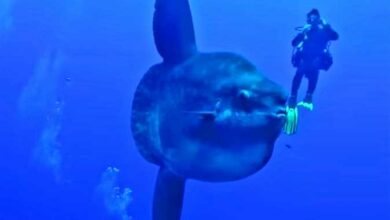
Some reef-dwelling fish are twice as likely to get gobbled up by predators in the presence of a noisy motorboat, according to a study released Friday.
The research, published in Nature Communications, adds to a growing body of evidence that noise pollution — on land and in the water — is a serious menace for wildlife.
Many mammals, birds and other animals use sound to locate food, avoid predators, navigate their environment, and even select a mate.
But all of these life-essential functions can be disrupted by noise from ships and sonar probes in the sea, motor vehicles and industry on land, or airplanes.
Sometimes the results are lethal.
The new study shows that when damselfish — a family of several hundred species found mostly in the tropics — become stressed by a motorboat overhead, their ability to evade predators is compromised.
The likely hunter in this case is the dusky dottyback, which likes to snack on young damselfish that have recently moved to reefs from the open sea, where they hatch.
Scientists led by Stephen Simpson of the University of Exeter conducted experiments in the lab and in the wild. Whether the noise came from a recording or a real boat, the outcome was the same.
The disoriented damselfish were six times less likely to dart away from an attack, and more than twice as likely to wind up as some other fish's meal, the study found.
"The combination of stress and poor responses to strikes by predators in why these fish become such easy prey," said Andy Radford, a co-author of the study and a researcher at the University of Bristol.
Scientists observed that the sound-addled fish consumed 20 to 30 percent more oxygen, a sure sign of distress.
Beached whales
Noise pollution in the ocean often occurs in areas densely populated with marine life.
Shallow water coral reefs, for example, cover far less than one percent of the ocean floor, but harbour more than a quarter of it's biodiversity.
Unfortunately for much of that fauna, humans also intensively exploit coral ecosystems, which means lots of motorboats. Some 500,000 will crisscross the waters above Australia's Great Barrier Reef by 2040, according to a government report.
Aggravating the impact, sound travels five times faster in water than in air, and — due to water's density — over far greater distances as well.
Damselfish, a common sight in salt-water aquariums, are not the only aquatic victims of human-induced sound.
Recent research has shown that pile-driving, seismic surveys and especially heavy traffic along coastal shipping lanes used by migrating whales have affected the giant sea mammals' ability to feed and communicate.
It has also fingered naval sonar as a suspect in the death of beaked whales so disoriented by the noise that they beach themselves, though the link cannot be proven experimentally.
On land, numerous studies have shown how noise pollution perturb animals as they gather food — or try to avoid becoming another creature's midnight snack.
Some species of bat, for example, depend not on sonar but highly-developed hearing to detect beetles or centipedes moving through dirt and dry leaves. Woodpeckers similarly cock their heads to listen for hidden bugs after pecking at a tree branch.
Commercial jets passing overhead or trucks rumbling along a nearby road may be just loud enough to mask these telltale sounds.




